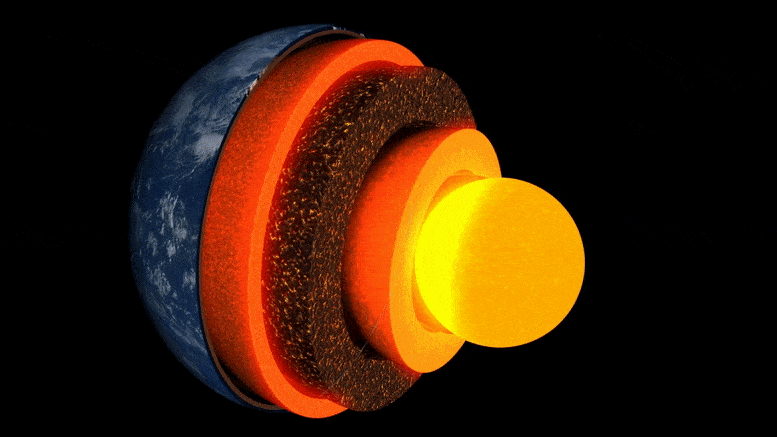
Анимация на земните слоеве.
Ново изследване, ръководено от университета в Кеймбридж, е първото, което получава детайлно „изображение“ на необичаен скален джоб в граничния слой със земното ядро, на около три хиляди километра под повърхността.
Мистериозният регион на скалите, разположен почти точно под Хавайските острови, е един от няколкото района с много ниска скорост – наречена така, защото земетръсните вълни се забавят до пълзене, докато преминават през тях.
Изследване, публикувано в списанието на 19 май 2022 г Природни комуникациие първият, който разкрива в детайли сложната вътрешна асиметрия на един от тези анклави, хвърляйки светлина върху дълбоките вътрешни пейзажи на Земята и процесите, протичащи в тях.
„От всички дълбоки вътрешни черти на Земята тази е най-прекрасната и сложна. – като мен
„От всички дълбоки вътрешни характеристики на Земята, това е най-завладяващо и сложно. Сега сме получили първото солидно доказателство, което показва вътрешната й структура – това е истински ориентир в дълбоката сеизмология“, каза водещият автор Джи Ли, докторант в катедрата по науки за Земята в Кеймбридж. земята“.
Вътрешността на Земята е оформена като лук: в центъра е желязо-никеловата сърцевина, заобиколена от дебел слой, известен като мантия, а отгоре тънка външна кора – кората, върху която живеем. Въпреки че мантията е твърда скала, тя е достатъчно гореща, за да тече много бавно. Вътрешните конвективни потоци доставят топлина към повърхността, причинявайки движение на тектоничните плочи и подхранвайки вулканични изригвания.
Учените използват сеизмични вълни от земетресения, за да „видят“ какво има под земната повърхност – ехото и сенките на тези вълни разкриват подобни на радар изображения на дълбоките вътрешности. Но доскоро „изображенията“ на структури на границата на ядрото и мантията, регион от основен интерес за изследване на вътрешния топлинен поток на нашата планета, бяха зърнести и трудни за интерпретиране.

Събитията и траекториите на Sdiff лъчите, използвани в това изследване. а) Напречно сечение, пресичащо центъра на района с ултра ниска скорост в Хавай, показващо траектории на лъчите за Sdiff вълни при 96°, 100°, 110° и 120° за 1D модела на Земята PREM. Прекъснатите линии отгоре надолу показват прекъсванията от 410 km, 660 km и 2791 km (100 km над границата ядро-мантия). б) Събития и траектории на Sdiff-лъчи на фонов томографски модел SEMUCB_WM1 на дълбочина 2791 km. Плажни топки за събития, боядисани в различни цветове, включително 20100,320 (жълто), 20111214 (зелено), 20120417 (червено), 20180910 (лилаво), 20180518 (кафяво), 20181030 (розово), 201611 (201611) , и лъчи. Траектории на вълните Sdiff на дълбочина на дупката от 2791 km в долната мантия, използвана в това изследване. Събитието, използвано в краткосрочния анализ, е маркирано в жълто. Предложеното местоположение на ULVZ е показано в черен кръг. Пунктираната линия показва напречното сечение, начертано в A. Кредит: Nature Communications, DOI: 10.1038/s41467-022-30502-5
Изследователите са използвали най-съвременни методи за числено моделиране, за да открият структури в километров мащаб на границата на ядрото и мантията. Според съавтора д-р Куангдай Ленг, който е разработил методите по време на[{“ attribute=““>University of Oxford, “We are really pushing the limits of modern high-performance computing for elastodynamic simulations, taking advantage of wave symmetries unnoticed or unused before.” Leng, who is currently based at the Science and Technology Facilities Council, says that this means they can improve the resolution of the images by an order of magnitude compared to previous work.
The researchers observed a 40% reduction in the speed of seismic waves traveling at the base of the ultra-low velocity zone beneath Hawaii. This supports existing proposals that the zone contains much more iron than the surrounding rocks – meaning it is denser and more sluggish. “It’s possible that this iron-rich material is a remnant of ancient rocks from Earth’s early history or even that iron might be leaking from the core by an unknown means,” said project lead Dr Sanne Cottaar from Cambridge Earth Sciences.

Conceptual cartoons of the Hawaiian ultra-low velocity zone (ULVZ) structure. A) ULVZ on the core–mantle boundary at the base of the Hawaiian plume (height is not to scale). B) a zoom in of the modeled ULVZ structure, showing interpreted trapped postcursor waves (note that the waves analyzed have horizontal displacement). Credit: Nature Communications, DOI: 10.1038/s41467-022-30502-5
The research could also help scientists understand what sits beneath and gives rise to volcanic chains like the Hawaiian Islands. Scientists have started to notice a correlation between the location of the descriptively-named hotspot volcanoes, which include Hawaii and Iceland, and the ultra-low velocity zones at the base of the mantle. The origin of hotspot volcanoes has been debated, but the most popular theory suggests that plume-like structures bring hot mantle material all the way from the core-mantle boundary to the surface.
With images of the ultra-low velocity zone beneath Hawaii now in hand, the team can also gather rare physical evidence from what is likely the root of the plume feeding Hawaii. Their observation of dense, iron-rich rock beneath Hawaii would support surface observations. “Basalts erupting from Hawaii have anomalous isotope signatures which could either point to either an early-Earth origin or core leaking, it means some of this dense material piled up at the base must be dragged to the surface,” said Cottaar.
More of the core-mantle boundary now needs to be imaged to understand if all surface hotspots have a pocket of dense material at the base. Where and how the core-mantle boundary can be targeted does depend on where earthquakes occur, and where seismometers are installed to record the waves.
The team’s observations add to a growing body of evidence that Earth’s deep interior is just as variable as its surface. “These low-velocity zones are one of the most intricate features we see at extreme depths – if we expand our search, we are likely to see ever-increasing levels of complexity, both structural and chemical, at the core-mantle boundary,” said Li.
They now plan to apply their techniques to enhance the resolution of imaging of other pockets at the core-mantle boundary, as well as mapping new zones. Eventually, they hope to map the geological landscape across the core-mantle boundary and understand its relationship with the dynamics and evolutionary history of our planet.
Reference: “Kilometer-scale structure on the core–mantle boundary near Hawaii” by Zhi Li, Kuangdai Leng, Jennifer Jenkins and Sanne Cottaar, 19 May 2022, Nature Communications.
DOI: 10.1038/s41467-022-30502-5

„Тотален фен на Twitter. Нежно очарователен почитател на бекона. Сертифициран специалист по интернет.“






More Stories
„Треска на ленивец“ или Оровирус навлезе в Съединените щати от Куба – ето какво трябва да знаете
Идентични следи от стъпки на динозаври открити на два континента
Най-мощният телескоп на Земята заснема изображения на черни дупки с безпрецедентни детайли